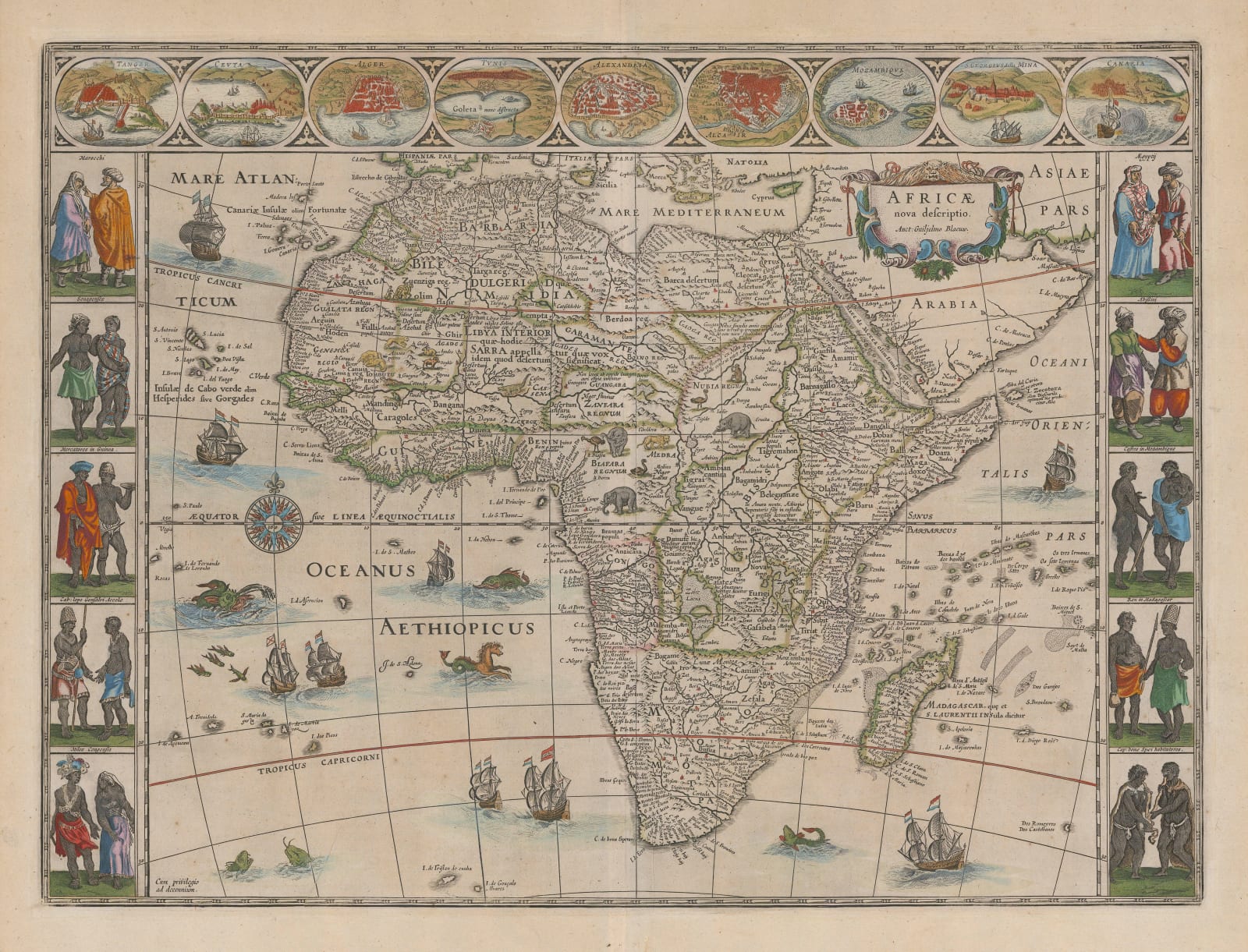Willem & Jan Blaeu
40 x 52 cm
When this map of Africa was first issued in 1617, it was part of a set of four maps of the continents which spear headed Willem Blaeu’s aggressive commercial drive into the market for atlases and loose sheet folio maps or separate publications, as they were known.
The map is essentially based on his own wall map of 1608 with the same basic design and geography. The sources Blaeu used are wide and diverse. Among its most salient geographical feature are the two huge lakes in the south central region which act as the source for the Nile. This is a concept that ultimately can be traced back to the description obtained from the work of Claudius Ptolemy, a Graeco-Egyptian cartographer who flourished c.150AD and who was the basis for the majority of medieval geography. The placement of these lakes meant that later map makers enthusiastically embraced them as sources for many of the major rivers of the continent, including the Congo and the Zambesi. This geographical interpretation went through several variations. Blaeu is using the interpretation of the 16th century Italian geographer Giacomo Gastaldi; his configuration and placement of the lakes and rivers separates Africa into two separate islands. The regions to the northeast and south of the Nile and the Congo form one island while regions to the northwest and west of the Nile and the Congo create the other. The source for both rivers is believed to be the mythical Lake Zaire.
Despite the problematic depiction above, Blaeu included several innovations on this map, mostly thanks to Portuguese discoveries and the frequency of Dutch voyages to and from the Far East. These all hugged the west coast of Africa, rounded the Cape of Good Hope and either sailed partly up the east coast or across the Indian Ocean towards Mauritius. Many of the place names were provided by Portuguese explorers as such as Cadamosto and de Gama. The information on the Cape was provided by Cornelis de Houten, who led the first Dutch expedition to the Far East. Even by the early 17th century, there were several small, mainly Portuguese, trading factories on the west coast.
The north coast was the domain of the powerful Ottoman Empire. That region was vastly wealthy as a result of the activities of the notorious Barbary Pirates, who made their home there. This continuous marine activity ensured that this coast was the most detailed part of the continent. In contrast, the interior is divided into political regions as understood by Europeans but this is based on reports and accounts of sailors and travellers several times removed from primary sources and often misunderstood.
Africa is generally acknowledged as the most decorative map of Blaeu’s set of continents. The continent has been used as a source for exotic animals since the classical period and Blaeu has sprinkled vignettes of creatures, both recognisable and fantastical, liberally throughout the continent. Multiple ships and sea monsters embellish the sea. However, the most striking feature are the illustrated borders. The side panels illustrate costumed figures of African inhabitants, sourced mainly from the works of Theodor de Bry and Hugo van Linschoten. The upper border showcases important urban centres; these are mainly on the north coast, including the cities of Algiers, Ceuta and Alexandria and are sourced from the Civitates Orbis Terrarum, published by Georg Braun and engraved mainly by Frans Hogenberg. The three views on the right, of S. George el Mina, Mozambique and Canaria were almost certainly based on de Bry’s images.
Blaeu’s map was hugely influential. It remained essentially unchanged through its publishing life with only very minor alterations distinguishing its states. Original colour. French text on verso (image available on request). [Betz 57] [AFR6306]


